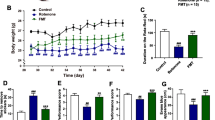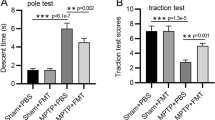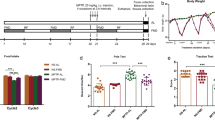Abstract
Rationale
Parkinson’s disease (PD) is a chronic and progressive neurodegenerative disorder. Increasing evidence suggests the role of the gut–microbiota–brain axis in the pathogenesis of PD. Mesenchymal stem-cell-derived microvesicles (MSC-MVs) have emerged as a therapeutic potential for neurological disorders over the last years.
Objective
The objective of this study was to investigate whether MSC-MVs could improve PD-like neurotoxicity in mice after administration of MPTP (1-methyl-4-phenyl-1,2,3,6-tetrahydropyridine).
Results
MPTP-induced reductions in the dopamine transporter and tyrosine hydroxylase expressions in the striatum and substantia nigra (SNr) were attenuated after a subsequent single administration of MSC-MVs. Increases in the phosphorylated α-synuclein (p-α-Syn)/α-Syn ratio in the striatum, SNr, and colon after MPTP injection were also attenuated after MSC-MVs injection. Furthermore, MSC-MVs restored MPTP-induced abnormalities of the gut microbiota composition. Interestingly, positive correlations between the genus Dubosiella and the p-α-Syn/α-Syn ratio were observed in the brain and colon, suggesting their roles in the gut–microbiota–brain communication. Moreover, MSC-MVs attenuated MPTP-induced reduction of the metabolite, 3,6-dihydroxy-2-[3-methoxy-4-(sulfooxy)phenyl]-7-(sulfinooxy)-3,4-dihydro-2H-1-benzopyran-5-olate, in the blood. Interestingly, a negative correlation between this compound and the p-α-Syn/α-Syn ratio was observed in the brain and colon.
Conclusions
These data suggest that MSC-MVs could ameliorate MPTP-induced neurotoxicity in the brain and colon via the gut–microbiota–brain axis. Therefore, MSC-MVs would have a new therapeutic potential for neurological disorders such as PD.








Similar content being viewed by others
Data availability
The 16S rRNA sequencing data have been deposited to the NCBI Sequence Read Archive and are available at the accession number PRJNA833302.
References
Ascherio A, Schwarzschild MA (2016) The epidemiology of Parkinson’s disease: risk factors and prevention. Lancet Neurol 15:1257–1272
Bitu Pinto N, da Silva Alexandre B, Neves KR, Silva AH, Leal LK, Viana GS (2015) Neuroprotective properties of the standardized extract from Camellia sinensis (green tea) and its main bioactive components, epicatechin and epigallocatechin gallate, in the 6-OHDA model of Parkinson’s disease. Evid Based Complement Alternat Med 2015:161092
Blagojević B, Agić D, Serra AT, Matić S, Matovina M, Bijelić S, Popović BM (2021) An in vitro and in silico evaluation of bioactive potential of cornelian cherry (Cornus mas L) extracts rich in polyphenols and iridoids. Food Chem 335:127619
Bonamonte D, Belloni Fortina A, Neri L, Patrizi A (2014) Fusidic acid in skin infections and infected atopic eczema. G Ital Dermatol Venereol 149:453–459
Boxall SA, Jones E (2012) Markers for characterization of bone marrow multipotential stromal cells. Stem Cells Int 2012:975871
Cai H, Wen Z, Meng K, Yang P (2021) Metabolomic signatures for liver tissue and cecum contents in high-fat diet-induced obese mice based on UHPLC-Q-TOF/MS. Nutr Metab (lond) 18:69–69
Chen H-X, Liang F-C, Gu P, Xu B-L, Xu H-J, Wang W-T, Hou J-Y, Xie D-X, Chai X-Q, An S-J (2020) Exosomes derived from mesenchymal stem cells repair a Parkinson’s disease model by inducing autophagy. Cell Death Dis 11:288
Cone AS, Yuan X, Sun L, Duke LC, Vreones MP, Carrier AN, Kenyon SM, Carver SR, Benthem SD, Stimmell AC, Moseley SC, Hike D, Grant SC, Wilber AA, Olcese JM, Meckes DG Jr (2021) Mesenchymal stem cell-derived extracellular vesicles ameliorate Alzheimer’s disease-like phenotypes in a preclinical mouse model. Theranostics 11:8129–8142
Ding T, Cao K, Fang W, Zhu G, Chen C, Wang X, Wang L (2020) Evaluation of phenolic components (anthocyanins, flavanols, phenolic acids, and flavonols) and their antioxidant properties of peach fruits. Sci Hortic 268:109365
Dinkins MB, Wang G, Bieberich E (2017) Sphingolipid-enriched extracellular vesicles and Alzheimer’s disease: a decade of research. J Alzheimers Dis 60:757–768
Dominiak A, Chełstowska B, Olejarz W, Nowicka G (2020) Communication in the cancer microenvironment as a target for therapeutic interventions. Cancers (basel) 12:1232
Fernández-Francos S, Eiro N, González-Galiano N, Vizoso FJ (2021) Mesenchymal stem cell-based therapy as an alternative to the treatment of acute respiratory distress syndrome: current evidence and future perspectives. Int J Mol Sci 22(15):7850
Fitzgerald E, Murphy S, Martinson HA (2019) Alpha-synuclein pathology and the role of the microbiota in Parkinson’s disease. Front Neurosci 13:369–369
Gordeeva O, Khaydukov S (2017) Tumorigenic and differentiation potentials of embryonic stem cells depend on TGFβ family signaling: lessons from teratocarcinoma cells stimulated to differentiate with retinoic acid. Stem Cells Int 2017:7284872–7284872
Holmqvist S, Chutna O, Bousset L, Aldrin-Kirk P, Li W, Björklund T, Wang ZY, Roybon L, Melki R, Li JY (2014) Direct evidence of Parkinson pathology spread from the gastrointestinal tract to the brain in rats. Acta Neuropathol 128:805–820
Jurj A, Zanoaga O, Braicu C, Lazar V, Tomuleasa C, Irimie A, Berindan-Neagoe I (2020) A comprehensive picture of extracellular vesicles and their contents. Molecular Transfer to Cancer. Cells Cancers (basel) 12:298
Kaidery NA, Banerjee R, Yang L, Smirnova NA, Hushpulian DM, Liby KT, Williams CR, Yamamoto M, Kensler TW, Ratan RR, Sporn MB, Beal MF, Gazaryan IG, Thomas B (2013) Targeting Nrf2-mediated gene transcription by extremely potent synthetic triterpenoids attenuate dopaminergic neurotoxicity in the MPTP mouse model of Parkinson’s disease. Antioxid Redox Signal 18:139–157
Kalia LV, Lang AE (2015) Parkinson’s disease. Lancet 386:896–912
Kim S, Kwon SH, Kam TI, Panicker N, Karuppagounder SS, Lee S, Lee JH, Kim WR, Kook M, Foss CA, Shen C, Lee H, Kulkarni S, Pasricha PJ, Lee G, Pomper MG, Dawson VL, Dawson TM, Ko HS (2019) Transneuronal propagation of pathologic α-synuclein from the gut to the brain models Parkinson’s disease. Neuron 103:627-641.e627
Klingelhoefer L, Reichmann H (2015) Pathogenesis of Parkinson disease—the gut–brain axis and environmental factors. Nat Rev Neurol 11:625–636
Lei Q, Wu T, Wu J, Hu X, Guan Y, Wang Y, Yan J, Shi G (2021) Roles of α-synuclein in gastrointestinal microbiome dysbiosis-related Parkinson’s disease progression (Review). Mol Med Rep 24:734
Li Z, Liu F, He X, Yang X, Shan F, Feng J (2019) Exosomes derived from mesenchymal stem cells attenuate inflammation and demyelination of the central nervous system in EAE rats by regulating the polarization of microglia. Int Immunopharmacol 67:268–280
Li Q, Chen G, Zhu D, Zhang W, Qi S, Xue X, Wang K, Wu L (2022) Effects of dietary phosphatidylcholine and sphingomyelin on DSS-induced colitis by regulating metabolism and gut microbiota in mice. J Nutr Biochem 105:109004
Luo S, Sun X, Huang M, Ma Q, Du L, Cui Y (2021) Enhanced neuroprotective effects of epicatechin gallate encapsulated by bovine milk-derived exosomes against Parkinson’s disease through antiapoptosis and antimitophagy. J Agric Food Chem 69:5134–5143
Malkki H (2017) Could gut microbiota influence severity of Parkinson disease? Nat Rev Neurol 13:66–67
Matthay MA, Pati S, Lee JW (2017) Concise review: mesenchymal stem (stromal) cells: biology and preclinical evidence for therapeutic potential for organ dysfunction following trauma or sepsis. Stem Cells 35:316–324
Maumus M, Rozier P, Boulestreau J, Jorgensen C, Noël D (2020) Mesenchymal stem cell-derived extracellular vesicles: opportunities and challenges for clinical translation. Front Bioeng Biotechnol 8:997–997
Meredith GE, Rademacher DJ (2011) MPTP mouse models of Parkinson’s disease: an update. J Parkinson Dis 1:19–33
Parashar A, Udayabanu M (2017) Gut microbiota: implications in Parkinson’s disease. Parkinsonism Relat Disord 38:1–7
Park H, Chang KA (2020) Therapeutic potential of repeated intravenous transplantation of human adipose-derived stem cells in subchronic MPTP-induced Parkinson’s disease mouse model. Int J Mol Sci 21:8129
Peister A, Zeitouni S, Pfankuch T, Reger RL, Prockop DJ, Raber J (2006) Novel onject recognition in Apoe-/- mice improved by neonatal implantation of wild-type multipotential stromal cells. Exp Neurol 201:266–269
Phinney DG, Prokop DJ (2007) Concise review: mesenchymal stem/multipotent stromal cells: the state of transdifferentiation and modes of tissue repair–current views. Stem Cells 25:2896–2902
Pu Y, Chang L, Qu Y, Wang S, Zhang K, Hashimoto K (2019) Antibiotic-induced microbiome depletion protects against MPTP-induced dopaminergic neurotoxicity in the brain. Aging (albany NY) 11:6915–6929
Pu Y, Yang J, Chang L, Qu Y, Wang S, Zhang K, Xiong Z, Zhang J, Tan Y, Wang X, Fujita Y, Ishima T, Wang D, Hwang SH, Hammock BD, Hashimoto K (2020) Maternal glyphosate exposure causes autism-like behaviors in offspring through increased expression of soluble epoxide hydrolase. Proc Natl Acad Sci U S A 117:11753–11759
Pu Y, Tan Y, Qu Y, Chang L, Wang S, Wei Y, Wang X, Hashimoto K (2021) A role of the subdiaphragmatic vagus nerve in depression-like phenotypes in mice after fecal microbiota transplantation from Chrna7 knock-out mice with depression-like phenotypes. Brain Behav Immun 94:318–326
Qu Y, Zhang K, Pu Y, Chang L, Wang S, Tan Y, Wang X, Zhang J, Ohnishi T, Yoshikawa T, Hashimoto K (2020) Betaine supplementation is associated with the resilience in mice after chronic social defeat stress: a role of brain–gut–microbiota axis. J Affect Disord 272:66–76
Romano S, Savva GM, Bedarf JR, Charles IG, Hildebrand F, Narbad A (2021) Meta-analysis of the Parkinson’s disease gut microbiome suggests alterations linked to intestinal inflammation. npj Parkinson’s Dis 7:27
Sakthiswary R, Raymond AA (2012) Stem cell therapy in neurodegenerative diseases: from principles to practice. Neural Regen Res 7:1822–1831
Scheperjans F, Aho V, Pereira PAB, Koskinen K, Paulin L, Pekkonen E, Haapaniemi E, Kaakkola S, Eerola-Rautio J, Pohja M, Kinnunen E, Murros K, Auvinen P (2015) Gut microbiota are related to Parkinson’s disease and clinical phenotype. Mov Disord 30:350–358
Segata N, Izard J, Waldron L, Gevers D, Miropolsky L, Garrett WS, Huttenhower C (2011) Metagenomic biomarker discovery and explanation. Genome Biol 12:R60
Shan J, Qu Y, Wang S, Wei Y, Chang L, Ma L, Hashimoto K (2021) Regulation of neurotoxicity in the striatum and colon of MPTP-induced Parkinson’s disease mice by gut microbiome. Brain Res Bull 177:103–110
Shannon KM, Keshavarzian A, Dodiya HB, Jakate S, Kordower JH (2012) Is alpha-synuclein in the colon a biomarker for premotor Parkinson’s disease? Evidence from 3 cases. Mov Disord: Off J Mov Disord Soc 27:716–719
Shinno-Hashimoto H, Hashimoto Y, Wei Y, Chang L, Fujita Y, Ishima T, Matsue H, Hashimoto K (2021) Abnormal composition of microbiota in the gut and skin of imiquimod-treated mice. Sci Rep 11:11265
Soares S, Soares S, Brandão E, Guerreiro C, Mateus N, de Freitas V (2020) Oral interactions between a green tea flavanol extract and red wine anthocyanin extract using a new cell-based model: insights on the effect of different oral epithelia. Sci Rep 10:12638
Soliman H, Theret M, Scott W, Hill L, Underhill TM, Hinz B, Rossi FMV (2021) Multipotent stromal cells: one name, multiple identities. Cell Stem Cell 28:1690–1707
Svensson E, Horváth-Puhó E, Thomsen RW, Djurhuus JC, Pedersen L, Borghammer P, Sørensen HT (2015) Vagotomy and subsequent risk of Parkinson’s disease. Ann Neurol 78:522–529
Teixeira MD, Souza CM, Menezes AP, Carmo MR, Fonteles AA, Gurgel JP, Lima FA, Viana GS, Andrade GM (2013) Catechin attenuates behavioral neurotoxicity induced by 6-OHDA in rats. Pharmacol Biochem Behav 110:1–7
Torres ERS, Akinyeke T, Stagaman K, Duvoisin RM, Meshul CK, Sharpton TJ, Raber J (2018) Effects of sub-chronic MPTP exposure on behavioral and cognitive performance and the microbiome of wild-type and mGlu8 knockout female and male mice. Front Behav Neurosci 12:140
Travagli RA, Browning KN, Camilleri M (2020) Parkinson disease and the gut: new insights into pathogenesis and clinical relevance. Nat Rev Gastroenterol Hepatol 17:673–685
Venkataramana NK, Pal R, Rao SA, Naik AL, Jan M, Nair R, Sanjeev CC, Kamble RB, Murthy DP, Chaitanya K (2012) Bilateral transplantation of allogenic adult human bone marrow-derived mesenchymal stem cells into the subventricular zone of Parkinson’s disease: a pilot clinical study. Stem Cells Int 2012:931902
Wang S, Qu Y, Chang L, Pu Y, Zhang K, Hashimoto K (2020) Antibiotic-induced microbiome depletion is associated with resilience in mice after chronic social defeat stress. J Affect Disord 260:448–457
Wang S, Ishima T, Qu Y, Shan J, Chang L, Wei Y, Zhang J, Pu Y, Fujita Y, Tan Y, Wang X, Ma L, Wan X, Hammock BD, Hashimoto K (2021) Ingestion of Faecalibaculum rodentium causes depression-like phenotypes in resilient Ephx2 knock-out mice: a role of brain-gut-microbiota axis via the subdiaphragmatic vagus nerve. J Affect Disord 292:565–573
Westfall S, Caracci F, Estill M, Frolinger T, Shen L, Pasinetti GM (2021) Chronic stress-induced depression and anxiety priming modulated by gut-brain-axis immunity. Front Immunol 12:670500
Yemula N, Dietrich C, Dostal V, Hornberger M (2021) Parkinson’s Disease and the gut: symptoms, nutrition, and microbiota. J Parkinsons Dis 11:1491–1505
Zhang Y, Liu Y, Liu H, Tang WH (2019) Exosomes: biogenesis, biologic function and clinical potential. Cell Biosci 9:19–19
Zhong W, Li Q, Xie G, Sun X, Tan X, Sun X, Jia W, Zhou Z (2013) Dietary fat sources differentially modulate intestinal barrier and hepatic inflammation in alcohol-induced liver injury in rats. Am J Physiol Gastrointest Liver Physiol 305:G919-932
Zhou T, Yuan Z, Weng J, Pei D, Du X, He C, Lai P (2021) Challenges and advances in clinical applications of mesenchymal stromal cells. J Hematol Oncol 14:24
Funding
This study was supported by the National Natural Science Foundation of China (to Y. Pu, no. 82101616), the China Postdoctoral Science Foundation (to Y. Pu, no. 281269), the Post-Doctor Research Project, West China Hospital, Sichuan University (to Y. Pu, no. 2021HXBH046), and the 1·3·5 project for disciplines of excellence, West China Hospital, Sichuan University (to Y. Liu, nos. ZYGD18015 and ZYJC18003).
Author information
Authors and Affiliations
Contributions
Y.P., K.H., and Y.L. contributed to conception and design of the study. Y.P., Q.W., Q.Z., T.H., J.W., and L.W. contributed to acquisition and analysis of data. Y.P. contributed to drafting the text or preparing the figures. Y.L. supervised the project. All authors approved the final version of the text.
Corresponding authors
Ethics declarations
Conflict of interest
The authors declare no competing interests.
Additional information
Publisher's note
Springer Nature remains neutral with regard to jurisdictional claims in published maps and institutional affiliations.
Supplementary Information
Below is the link to the electronic supplementary material.
Rights and permissions
Springer Nature or its licensor (e.g. a society or other partner) holds exclusive rights to this article under a publishing agreement with the author(s) or other rightsholder(s); author self-archiving of the accepted manuscript version of this article is solely governed by the terms of such publishing agreement and applicable law.
About this article
Cite this article
Pu, Y., Wu, Q., Zhang, Q. et al. Mesenchymal stem-cell-derived microvesicles ameliorate MPTP-induced neurotoxicity in mice: a role of the gut–microbiota–brain axis. Psychopharmacology 240, 1103–1118 (2023). https://doi.org/10.1007/s00213-023-06348-0
Received:
Accepted:
Published:
Issue Date:
DOI: https://doi.org/10.1007/s00213-023-06348-0




